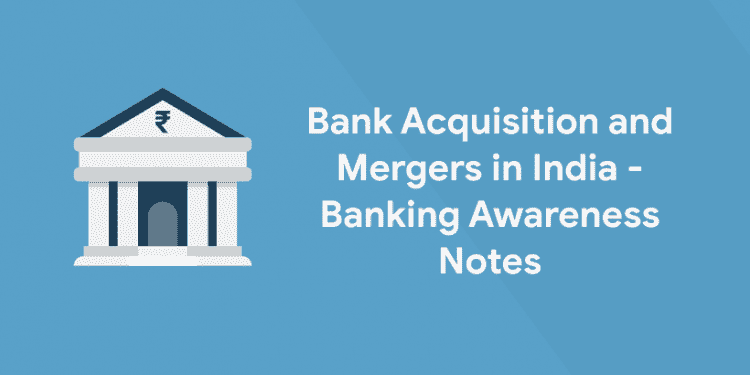Table of Contents
“For this reason, a man will leave his father and mother and be united to his wife, and the two will become one flesh. So, they are no longer two, but one flesh.” This is one of the bible quotes that often read during the Christian marriages telling them that they are no longer two but one. Don’t worry the religion and bible has nothing to do with the banking merger and acquisition. This is actually the basic concept behind the banking merger and banking acquisition. Banking entrance question will always have a major habit of throwing questions from the banking awareness. Bank acquisition and merger is one of the important topics in the banking awareness questions that often asked in the exam and not only that is one of the highly anticipated area in all the bank exams of the year 2020-2021. Through this article we are discussing the bank acquisition and mergers in India.
What is Bank Acquisition and Merger?
The banking system in India has undoubtedly earned numerous outstanding achievements, in a comparatively short time, for the World’s largest and the most diverse democracy. There have been several reforms in the Indian banking sector, as well as quite a few successful mergers and acquisitions, which have helped it, grow manifold. In Indian banking sector Mergers and acquisitions has become admired trend throughout the country. A large number of public sector bank, private sector bank and other banks are engaged in mergers and acquisitions activities in India. Mergers and acquisitions are the important process in the banking industry to make financial gains enormously. Main aim of merger and acquisition in the banking sectors is to improve the economies of scale.
What are the Other Important Banking Awareness Topics
What is Merger?
A merger means combination of two companies into one company. During the merging process one company survives and the other company loses their corporate existence. A merger is a deal to unite two existing companies into one new company. There are several types of mergers and also several reasons why companies’ complete mergers. Most mergers unite two existing companies into one newly named company. Mergers and acquisitions are commonly done to expand a company’s reach, expand into new segments, or gain market share.
The amalgamation of five associate banks of the State Bank of India (SBI) with the parent is the biggest merger in recent times. The union cabinet has approved the proposal whereby State Bank of Bikaner and Jaipur (SBBJ), State Bank of Travancore (SBT), State Bank of Mysore (SBM), State Bank of Patiala and the State Bank of Hyderabad merged with SBI. The Bharatiya Mahila Bank (BMB) also got merged with SBI, as part of the move.
What is Acquisition?
An acquisition means takeover. An acquisition is a corporate action in which a company buys most, if not all, of another firm’s ownership stakes to assume control of it. An acquisition occurs when a buying company obtains more than 50% ownership in a target company. As part of the exchange, the acquiring company often purchases the target company’s stock and other assets, which allows the acquiring company to make decisions regarding the newly acquired assets without the approval of the target company’s shareholders.
The History of Bank Acquisition and Mergers
1: What does the acronym "ATM" stand for in banking?
The bank acquisition and mergers are one of the greatest reforms that the Indian banking sector has witnessed. Before we look into the history of the mergers and acquisition, we need to understand the Indian banking sector and its growth in three phases.
Phase I: (1786- 1969) – Initial phase of banking in India when many small banks were set up
Phase II: (1969- 1991) – Nationalisation, regularisation and growth
Phase III: (1991 onwards) – Liberalisation and its aftermath
The year 1968 witnessed an ordinance issued by the Government of India and 14 large commercial banks in the country were nationalized. These fourteen banks, back then, contained a whooping eighty-five per cent of the total bank deposits in our country. 1980, was witness to yet another round of nationalization and six more commercial banks came under the government control. With this huge leap, an enormous ninety-one per cent of the banking sector came under direct control of the Indian Government. With this, the number of nationalized banks in India rose to twenty. Sometime later, in the year 1993, the government took yet another stride towards economic prosperity and made a turn towards merger of banks. The New Bank of India was merged with the Punjab National Bank (PNB). This was the first merger between nationalized banks, ever witnessed in Indian history. The Bank acquisition and merger was given an outmost priority in the Narasimhan Committee 1997 which the committee report gave suggestions enhancing the Indian banking sector. This has also accelerated the bank acquisition and mergers in India.
Read More about the History of Indian Banking Sector
Enroll in Kerala's Top-rated Bank Coaching Program!
Are you ready to take your banking career aspirations to new heights? Join Entri App's Bank Exam Coaching program to kickstart your preparations!
Join Now!The Major Bank Acquisition and Mergers in India
| Year | Acquiring bank | Targeted banks |
| 1993 | Punjab National Bank | New Bank of India |
| 1994 | Bank of India | Bank of Karad Ltd. |
| 1995 | State Bank of India | Kashinath State Bank |
| 1996 | Oriental Bank of Commerce | Punjab Co-op Ltd |
| 1997 | Oriental Bank of Commerce | Bari Doab bank Ltd. |
| 1999 | Union Bank of India | Sikkim Bank Ltd. |
| Bank Of Baroda | Barielly Co-op Ltd | |
| 2000 | HDFC Bank Ltd | Times Bank Ltd |
| 2001 | ICICI Bank | Bank of Madura |
| 2002 | Bank Of Baroda | Banaras State Bank Ltd |
| ICICI Bank | ICICI Ltd | |
| 2003 | Punjab National Bank | Nedungadi Bank Ltd. |
| 2004 | Oriental Bank of Commerce | Global Trust Bank |
| Bank of Baroda | South Gujarat Local Area Bank | |
| Industrial Development Bank of India | IDBI Bank Ltd. | |
| 2005 | Bank of Punjab | Centurion Bank |
| 2006 | ICICI Bank | Sangli Bank |
| Centurion Bank of Punjab | Lord Krishna Bank | |
| Industrial Development Bank of India | United western Bank | |
| Federal Bank | Ganesh Bank of Kurandwad | |
| 2007 | Indian Overseas Bank | Bharat Overseas Bank |
| 2008 | HDFC Bank | Centurion Bank of Punjab |
| 2010 | ICICI Bank | Bank of Rajasthan Ltd. |
| 2014 | Kotak Mahindra Bank | ING Vyasa Bank |
| 2017 | State Bank of India | State Bank of Bikaner and Jaipur
State Bank of Patiala State Bank of Mysore State Bank of Travancore State Bank of Hyderabad Bharatiya Mahila Bank |
Download Entri for More Updates
The Indian Acts enacted in purpose of mergers and acquisition
Mergers-Banking Regulation Act,1949
- Section 44A of this act talks about the procedures for voluntary mergers of banking companies.
- Section 45 of this act talks about the compulsory amalgamation of banks.
Companies Act
- Section 230 and 232 of the Companies Act,2013 relates with the mergers and amalgamation.
State Bank of India, 1955
- Section 35 states acquisition of business of other banks by State Bank of India.
Impact of the Indian banking sector through bank acquisition and mergers.
- Increases the technology the firm uses
- The Managerial skill will be increased
- Revamped developmental plans
- Income tax benefits
- Strategic purposes
- Revamped and increased supply of various banking products
- Purchase of assets
- Growth of the firm and thus of the Indian banking sector
Enroll in Kerala's Top-rated Bank Coaching Program!
Are you ready to take your banking career aspirations to new heights? Join Entri App's Bank Exam Coaching program to kickstart your preparations!
Join Now!Entri and Banking Preparation.
The bank acquisition and mergers are one of the major important topics of the banking exams. Its is not at all possible to study all regarding the bank acquisition and merges since it is a highly sophisticated subject that covers the banking theories and corporate economics theories. To know all regarding the bank acquisitions and mergers and all the consequences of the process and impact on the economy as well as the Indian banking sector one need to have a detailed study with good mentoring. By understanding the need of the aspirants Entri offers Banking 2.0 course with all new video classes integrated with it. The all new video classes are offered by the subject experts which forms one of the greatest faculty of the country. They will deal you about the deep sophisticated subjects such as bank acquisitions and mergers.
Conclusion
The bank acquisition and mergers are some of the corporate business and economic policy management of the government. But as a banking career aspirant it is one of the most important area to prepare and excel since it is the pampered section of the recruiters for the question pool. Study with Entri to have a concrete understanding of bank acquisition and mergers through Banking 2.0 all new video classes. Keep studying and keep winning.












